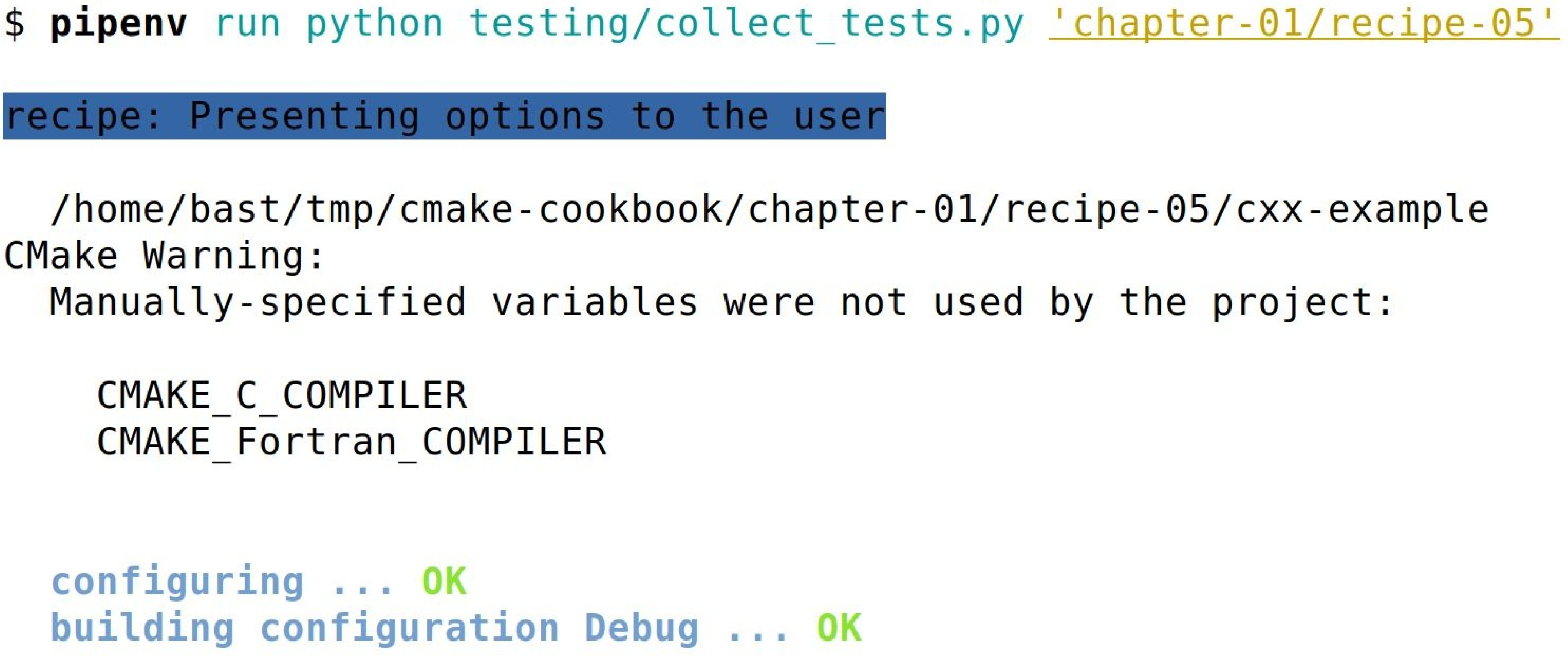# 0.4 测试环境
示例在下列持续集成(CI)上进行过测试:
* Travis( https://travis-ci.org )用于GNU/Linux和macOS
* Appveyor( https://www.appveyor.com )用于Windows
* CircleCI ( https://circleci.com )用于附加的GNU/Linux测试和商业编译器
CI服务的配置文件可以在示例库中找到( https://github.com/dev-cafe/cmake-cookbook/ ):
* Travis的配置文件为`travis.yml`
* Appveyor的配置文件为`.appveyor.yml`
* CircleCI的配置文件为`.circleci/config.yml`
* Travis和Appveyor的其他安装脚本,可以在` testing/dependencies`文件夹中找到。
**NOTE**:*GNU/Linux系统上,Travis使用CMake 3.5.2和CMake 3.12.1对实例进行测试。macOS系统上用CMake 3.12.1进行测试。Appveyor使用CMake 3.11.3进行测试。Circle使用CMake 3.12.1进行测试。*
测试机制是一组Python脚本,包含在`testing`文件夹中。脚本`collect_tests.py`将运行测试并报告它们的状态。示例也可以单独测试,也可以批量测试;` collect_tests.py`接受正则表达式作为命令行输入,例如:
```shell
$ pipenv run python testing/collect_tests.py 'chapter-0[1,7]/recipe-0[1,2,5]'
```
该命令将对第1章和第7章的示例1、2和5进行测试。输出的示例如下:

要获得更详细的输出,可以设置环境变量`VERBOSE_OUTPUT=ON`:
```shell
$ env VERBOSE_OUTPUT=ON pipenv run python testing/collect_tests.py 'chapter-*/recipe-*'
```
- Introduction
- 前言
- 第0章 配置环境
- 0.1 获取代码
- 0.2 Docker镜像
- 0.3 安装必要的软件
- 0.4 测试环境
- 0.5 上报问题并提出改进建议
- 第1章 从可执行文件到库
- 1.1 将单个源文件编译为可执行文件
- 1.2 切换生成器
- 1.3 构建和链接静态库和动态库
- 1.4 用条件句控制编译
- 1.5 向用户显示选项
- 1.6 指定编译器
- 1.7 切换构建类型
- 1.8 设置编译器选项
- 1.9 为语言设定标准
- 1.10 使用控制流
- 第2章 检测环境
- 2.1 检测操作系统
- 2.2 处理与平台相关的源代码
- 2.3 处理与编译器相关的源代码
- 2.4 检测处理器体系结构
- 2.5 检测处理器指令集
- 2.6 为Eigen库使能向量化
- 第3章 检测外部库和程序
- 3.1 检测Python解释器
- 3.2 检测Python库
- 3.3 检测Python模块和包
- 3.4 检测BLAS和LAPACK数学库
- 3.5 检测OpenMP的并行环境
- 3.6 检测MPI的并行环境
- 3.7 检测Eigen库
- 3.8 检测Boost库
- 3.9 检测外部库:Ⅰ. 使用pkg-config
- 3.10 检测外部库:Ⅱ. 自定义find模块
- 第4章 创建和运行测试
- 4.1 创建一个简单的单元测试
- 4.2 使用Catch2库进行单元测试
- 4.3 使用Google Test库进行单元测试
- 4.4 使用Boost Test进行单元测试
- 4.5 使用动态分析来检测内存缺陷
- 4.6 预期测试失败
- 4.7 使用超时测试运行时间过长的测试
- 4.8 并行测试
- 4.9 运行测试子集
- 4.10 使用测试固件
- 第5章 配置时和构建时的操作
- 5.1 使用平台无关的文件操作
- 5.2 配置时运行自定义命令
- 5.3 构建时运行自定义命令:Ⅰ. 使用add_custom_command
- 5.4 构建时运行自定义命令:Ⅱ. 使用add_custom_target
- 5.5 构建时为特定目标运行自定义命令
- 5.6 探究编译和链接命令
- 5.7 探究编译器标志命令
- 5.8 探究可执行命令
- 5.9 使用生成器表达式微调配置和编译
- 第6章 生成源码
- 6.1 配置时生成源码
- 6.2 使用Python在配置时生成源码
- 6.3 构建时使用Python生成源码
- 6.4 记录项目版本信息以便报告
- 6.5 从文件中记录项目版本
- 6.6 配置时记录Git Hash值
- 6.7 构建时记录Git Hash值
- 第7章 构建项目
- 7.1 使用函数和宏重用代码
- 7.2 将CMake源代码分成模块
- 7.3 编写函数来测试和设置编译器标志
- 7.4 用指定参数定义函数或宏
- 7.5 重新定义函数和宏
- 7.6 使用废弃函数、宏和变量
- 7.7 add_subdirectory的限定范围
- 7.8 使用target_sources避免全局变量
- 7.9 组织Fortran项目
- 第8章 超级构建模式
- 8.1 使用超级构建模式
- 8.2 使用超级构建管理依赖项:Ⅰ.Boost库
- 8.3 使用超级构建管理依赖项:Ⅱ.FFTW库
- 8.4 使用超级构建管理依赖项:Ⅲ.Google Test框架
- 8.5 使用超级构建支持项目
- 第9章 语言混合项目
- 9.1 使用C/C++库构建Fortran项目
- 9.2 使用Fortran库构建C/C++项目
- 9.3 使用Cython构建C++和Python项目
- 9.4 使用Boost.Python构建C++和Python项目
- 9.5 使用pybind11构建C++和Python项目
- 9.6 使用Python CFFI混合C,C++,Fortran和Python
- 第10章 编写安装程序
- 10.1 安装项目
- 10.2 生成输出头文件
- 10.3 输出目标
- 10.4 安装超级构建
- 第11章 打包项目
- 11.1 生成源代码和二进制包
- 11.2 通过PyPI发布使用CMake/pybind11构建的C++/Python项目
- 11.3 通过PyPI发布使用CMake/CFFI构建C/Fortran/Python项目
- 11.4 以Conda包的形式发布一个简单的项目
- 11.5 将Conda包作为依赖项发布给项目
- 第12章 构建文档
- 12.1 使用Doxygen构建文档
- 12.2 使用Sphinx构建文档
- 12.3 结合Doxygen和Sphinx
- 第13章 选择生成器和交叉编译
- 13.1 使用CMake构建Visual Studio 2017项目
- 13.2 交叉编译hello world示例
- 13.3 使用OpenMP并行化交叉编译Windows二进制文件
- 第14章 测试面板
- 14.1 将测试部署到CDash
- 14.2 CDash显示测试覆盖率
- 14.3 使用AddressSanifier向CDash报告内存缺陷
- 14.4 使用ThreadSaniiser向CDash报告数据争用
- 第15章 使用CMake构建已有项目
- 15.1 如何开始迁移项目
- 15.2 生成文件并编写平台检查
- 15.3 检测所需的链接和依赖关系
- 15.4 复制编译标志
- 15.5 移植测试
- 15.6 移植安装目标
- 15.7 进一步迁移的措施
- 15.8 项目转换为CMake的常见问题
- 第16章 可能感兴趣的书
- 16.1 留下评论——让其他读者知道你的想法
